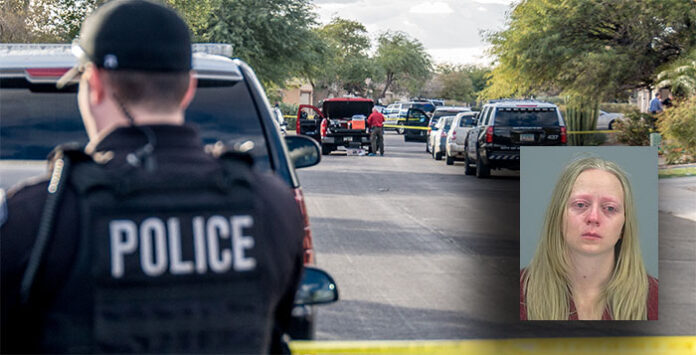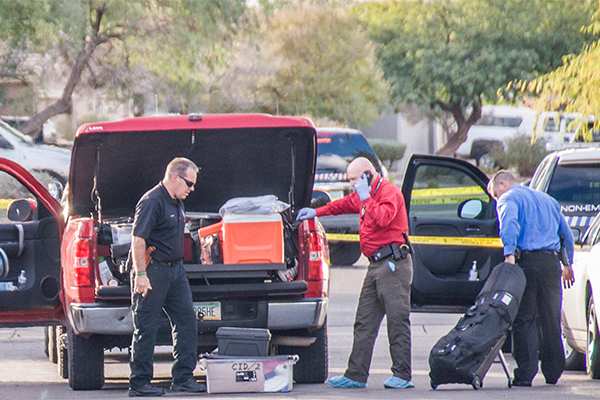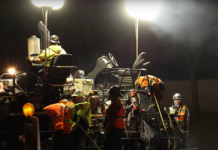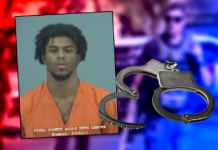
The second day of Kathryn Sinkevitch’s first-degree murder trial opened with the testimony of Maricopa Police Sgt. Daniel Rauch.
The day was filled with police officers telling the jury about their investigation into the murder of Michael Agerter. During testimony of a Maricopa Police detective, photographs of the murder victim were openly shared to the jury and the victim’s family.
Sinkevitch is accused in the shooting death of 31-year-old Agerter on Dec. 16, 2016.
Agerter, her ex-boyfriend, was shot and killed in the garage of his rental home in Rancho El Dorado. The two lived separately but had an infant son together.
The initial call of shots fired that day came across radio at 2:28 p.m. Police also were told about a white van leaving the murder scene. Rauch testified how he saw a white van at Honeycutt Road turning south on Hartman right after the call came in. He stopped the vehicle with two female occupants in it.
He said the van was stopped based on the description of the suspect van from the murder scene, and he didn’t believe the two women were involved in the shots-fired call.
He then went to the scene of the crime. He was part of the team who cleared the house.
Rauch said he observed at least one video camera on the outside of the house when he arrived at the scene and he noticed a digital video recorder during a search of the house.
He discovered the victim was involved in a custody issue with Sinkevitch during initial stages of the investigation.
Defense attorney Brett Huggins suddenly asked for a sidebar in chambers just 15 minutes into Rauch’s testimony, and Pinal County Superior Court Judge Kevin D. White removed jury. The court was recessed while attorneys from both sides talked.
The sidebar discussion was over linking the Bridgett Hopkins van to Sinkevitch via a license plate reader. The license plate reader linked a van belonging to Hopkins, Sinkevitch’s friend, to the area of the murder. Police believe the van was used in the murder and still have it in the impound lot.
Judge White placed a limit on the prosecution’s questions regarding the license plate reader.
After the jury was returned to the courtroom, Rauch said he got information about Hopkins’ van in Mesa and Sinkevitch’s cellphone information.
Police requested a pinging of her phone to find her from her cell phone provider. Sinkevitch was in Tempe, based on the pings, Rauch said. A team of law enforcement officers drove from Maricopa to Tempe to find Sinkevitch, but her location kept changing.
Sinkevitch was finally located in the area of Hopkins’ house in Mesa, based on the cellphone pings. Officers found Sinkevitch’s vehicle in Hopkins’ driveway, along with the van they believe to be used in the murder, Rauch said.
He said officers put together a plan to capture Sinkevitch in the house, as she was already a suspect at the time. Officers had their guns drawn but not aimed at the suspects when they came out of the house in Mesa, he testified.
Officers detained Sinkevitch to conduct an interview with her, and she was placed in a patrol car after being handcuffed, according to Rauch. She was in the vehicle “for a couple of hours” in handcuffs. She was then taken to the Maricopa Police Department for interrogation.
Rauch said additional search warrants were drafted a few days later to locate Sinkevitch after she was let go. At that point, she was wanted for the murder.
Detective Michael Dennison, a Maricopa Police detective for seven years, testified he was called to the murder scene about 10 minutes after the initial call came in.
He said Agerter was found dead of gunshot wounds. He was slumped over the wheel of his Lexus with the motor running in the garage of his house. Dennison also said Sinkevitch’s name came up as a potential suspect within 15 minutes during a background check of the victim.
Dennison was at the victim’s house for eight to nine hours investigating.
He said there was a DVR in the house, and he viewed the footage from four cameras set up around the house.
He explained the video showing a woman, wearing a hoodie, running in front of the house, into the garage, stay for 10 to 11 seconds and then leaving. The video also shows a white minivan drive away after the shooting.
He said the camera angles were from above and did not recorded the face of the person running into the garage.
He said two 40-caliber shell casings were found in the garage during the investigation.
Dennison said he later viewed an interview with Sinkevitch. She told police she was at work all day and didn’t even leave for lunch.
Dennison said surveillance video from her work contradicts Sinkevitch’s statements of not leaving the building. She is allegedly seen leaving at 12:30 or 12:45 and returning three hours later, about an hour after the murder occurred.
The video from the mortgage company where she worked was also used to get a search warrant of her apartment.
During a search, investigators didn’t find a shoe that fit a shoe print found at the murder scene. The shoes Sinkevitch had on when she was first arrested at Hopkins’ place were also examined. The pattern did not match the print found, but the shoe was the right size, he testified.
No shoes matching the print at the murder scene were found.
Dennison attended the victim’s autopsy, and then also examined data related to Sinkevitch’s cellphone. The data traces the cell phone as it moves.
Her cellphone’s historical data information showed Sinkevitch leaving from work at 12:30 the day of the murder, he said. It tracked her to a location near her apartment in just 15 minutes. It was at that location until 1:30 when the phone was apparently turned off. The data continues missing until 5 minutes before Sinkevitch returned to work at the mortgage company.
Police searched Sinkevitch’s vehicle and discovered two license plates that were not associated with her vehicle or Hopkins’ van. Dennison said the plates were from an area near Sinkevitch’s apartment but did not say if they were stolen.
Prosecutors showed images of the crime scene, including photos of the victim dead in the car. Dennison said two of three gunshots fired hit the victim. One round hit the pillar between the front and rear door. Family members began weeping when seeing the pictures.
Dennison said Sinkevitch’s cellphone disappeared from data collection at 1:13 p.m. that day. He testified that he drove suspected routes he believes Sinkevitch could have driven in the commission of the murder. He drove 27 miles from Sinkevitch’s apartment to Agerter’s house in 35 minutes. He left Sinkevitch apartment at 1:07 p.m. and arrived at 1:42 p.m. during the test on Jan. 12, 2017.
In another test, the following day, Dennison said he tried another route and made the trip in 45 minutes and it was 26 miles.
Dennison also made a test trip from the mortgage company where she worked to Sinkevitch’s house. He made the trip in 10 minutes. His test trips between the mortgage company and Agerter’s house took 47 minutes at 31.8 miles.
He said Sinkevitch was “very capable” of getting from work to her house to Agerter’s house and back to work during the time she left work on the day of the murder. Dennison said he never broke the posted speed limits on the roads he tested.
Dennison examined the ADOT traffic patterns on the day of the murder, and there were no recorded traffic problems on the routes during the timeframe involved.
Maricopa Police Detective Mario Palacios testified he arrived at the scene at 4:15 p.m. that day, and other detectives brought him up to speed.
He spoke with a potential witness in the neighborhood. He viewed the home security video and noted seeing a female walking up to the house wearing a dark hoodie and tan pants. She was gone for 10-11 seconds and was then seen leaving in a hurry on the video. He said part of a white van was visible across the street. When the van took off, he said, it is wasn’t possible to see who was in the van.
Prosecutors then showed the video to the jury.
Palacios said on the day Sinkevitch was arrested, he searched Hopkins white van and found a dark hoodie in the van.
Kyle Sobotik, Sinkevitch’s supervisor at the mortgage company, testified Sinkevitch worked for the support team, helping loan officers with problems.
He said Sinkevitch was a very good worker and he had no issues with her. He also said it was unusual for her to be gone for an extended time when she was supposed to be at work.
Sobotik said Sinkevitch “didn’t seem all with it” the Monday following the murder, which occurred on Friday. He said she “kind of looked like a ghost.”
He said he checked her emails from that Friday, the day of the murder, and found more than a two-hour gap, and “that wasn’t like Kathryn. It kind of stood out.”
He said she also didn’t clock out for lunch that day.
Under cross examination, Sobotik said he didn’t see anything “strange” on the day of the murder in the office but he added he wasn’t looking for it.
Roy Rankin, a co-worker of Sinkevitch, was a member of the sales support staff when the murder occurred.
On the day of the murder, Rankin said he sat next to Sinkevitch and said they interacted with each other all the time. He said she was very knowledgeable and kind of “carried the workload of the team.”
Rankin said Sinkevitch talked about her ex-boyfriend, Agerter, and the custody of the baby. She told Rankin that Agerter was getting a DNA test and added, “she wasn’t very happy about it.”
Rankin said Sinkevitch asked him if he knew anyone who had a baby she could borrow for the DNA tests. Later under cross examination he said she did not think she was joking and, “if I would have had a baby, I think she would have taken me up on it.”
Rankin said Sinkevitch was late back from lunch on the day of the murder and kept to herself after she got back. He said she was clearly distracted that afternoon.
At 5 p.m. when the office closed for the day, Sinkevitch left right away. He said she normally would stay and make sure all the work was done for the day.
The trial will reconvene Friday at 10:30 a.m.








![Elena Trails releases home renderings An image of one of 56 elevation renderings submitted to Maricopa's planning department for the Elena Trails subdivison. The developer plans to construct 14 different floor plans, with four elevation styles per plan. [City of Maricopa]](https://www.inmaricopa.com/wp-content/uploads/2024/04/city-041724-elena-trails-rendering-218x150.jpg)

![Affordable apartments planned near ‘Restaurant Row’ A blue square highlights the area of the proposed affordable housing development and "Restaurant Row" sitting south of city hall and the Maricopa Police Department. Preliminary architectural drawings were not yet available. [City of Maricopa]](https://www.inmaricopa.com/wp-content/uploads/2024/04/041724-affordable-housing-project-restaurant-row-218x150.jpg)







